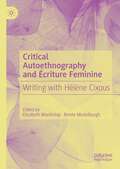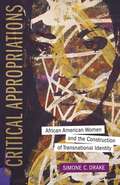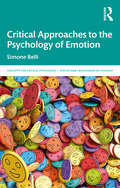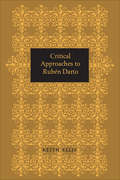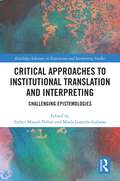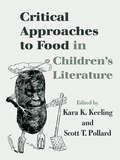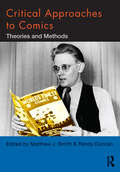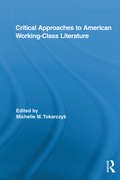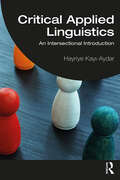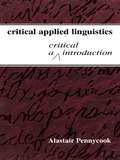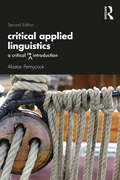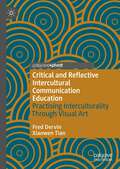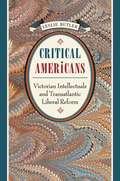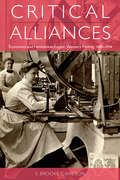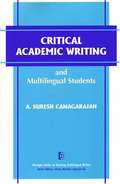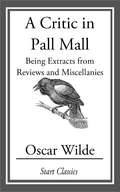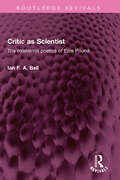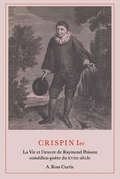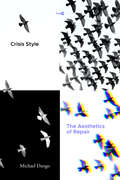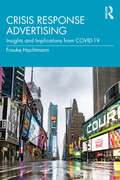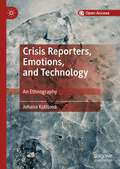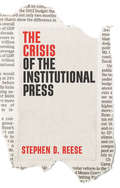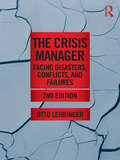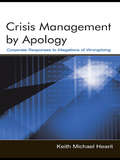- Table View
- List View
Critical Authoethnography and Écriture Feminine: Writing with Hélène Cixous
by Elizabeth Mackinlay Renée MickelburghThe project offers a collection of new interdisciplinary critical autoethnographic engagements with Hélène Cixous écriture feminine and work Three steps on the ladder of writing. Critical autoethnography shares a reciprocal, and inter-animating relationship with Hélène Cixous’ écriture feminine (“feminine writing”), and in this collection authors explore that inter-animation by explicitly engaging with Three steps on the ladder of writing. Three steps is a poetic, insightful, and ultimately moving reflection on the writing process and explores three distinct areas essential for writing: The School of the Dead—the notion that something or someone must die in order for good writing to be born; The School of Dreams—the crucial role dreams play in literary inspiration and output; and The School of Roots—the importance of depth in the 'nether realms' in all aspects of writing. Topics covered include: ways Cixous’ work can address the need for loss and reparation in writing critical autoethnography, how Cixous’ writing “makes our body speak” through concepts of birth and the body in, through and of critical autoethnography, whether writing in this way recast and reform prevailing orders of domination and oppression, and how Cixous’ writing around the ethics of loving and giving translates into response-able and non-violent forms of critical autoethnography in relation to otherness and difference. In this collection, we invite you to “Let us go to the school of [critical autoethnographic] writing” (Cixous, 1993, p. 3) with the work of Hélène Cixous, and speak in a different way and through a different medium of academic language, in an approach that reveals the tensions, the paradoxes, the pains and the pleasures of writing with critical autoethnography in the contemporary university.
Critical Appropriations: African American Women and the Construction of Transnational Identity (Southern Literary Studies)
by Simone C. DrakeFrom the novels of Toni Morrison to the music of Beyoncé Knowles, the cultural prevalence of a transnational black identity, as created by African American women, is more than a product of geographic mobility. Rather, as author Simone C. Drake shows, these constructions illuminate our understanding of a chronically marginalized demographic. In Critical Appropriations, Drake contends that these fluid and hetero-geneous characterizations of black females arise from multiple creative outlets -- literature, film, and music videos -- and reflect African Ameri-can women's evolving concept of home, community, gender, and family.Through a close examination of Toni Morrison's Paradise, Danzy Senna's Caucasia, Gayl Jones's Corregidora, Erna Brodber's Louisiana, and Kasi Lemmons's film Eve's Bayou, as well as Beyoncé Knowles's B-Day album and music-video collaboration with Shakira, "Beautiful Liar," Drake reveals how concepts of hybridity -- whether positioned as créolité, Candomblé, négritude, Latinidad, or Brasilidade -- are appropriated in each work of art as a way of challenging the homogeneous paradigm of black cultural studies. This redefined notion of identity enables African American women to embrace a more complex, transnational blackness that is not only more liberating but also more pertinent to their experiences. Drawing from this borderless exchange of ideas and a richer concept of self, Critical Appropriations offers a rewarding reconsideration of the creative implications for African American women, mapping new directions in black women's studies.
Critical Approaches to the Psychology of Emotion (Concepts for Critical Psychology)
by Simone BelliThis fascinating book explores the different methodologies, resources and strategies that have been used to study emotion, and identifies emerging trends and research perspectives in the field. Emotion is a subject that has been thoroughly investigated in all fields of social and behavioural sciences. And yet the more we have attempted to individualize emotions and set limits that separate the different types of emotions, the more the subject has resisted these categorizations. Mapping the changes and diverse perspectives in the study of emotion, author Simone Belli explores how a critical psychology of emotion has emerged in order to answer this paradox, examining emotions within a social framework. Divided into five chapters, the book uses interdisciplinary critical approaches to cover everything from the interaction between emotion and language, to emotional contagion such as the spread of fear in a pandemic. There is also a particular focus on emotion analysis in digital environments, which have left a deep mark on our lives from the beginning of this century. Showcasing a selection of important investigations that have dealt with the study of emotions in society, Critical Approaches to the Psychology of Emotion is essential reading for students of critical social psychology, sociolinguistics, sociology, anthropology and philosophy.
Critical Approaches to Rubén Darío
by Keith EllisRubén Darío (1867-1916) of Nicaragua was the leader of the important Latin American literary movement known as Modernism. He is considered by many to be the greatest poet in Latin American literature, and the volume of writings devoted to his work since 1884 is perhaps greater than that on any other writer in the history of Spanish American literature. The celebration in 1967 of the centenary of his birth gave rise to a formidable number of new analyses, increasing the need for the classification and assessment of the many studies. In this book Professor Ellis examines and evaluates the wide range of methods and perspectives available to the reader of Darío's works. He considers the biographical approach, social and political questions, influences and sources, structural analysis (providing three structural studies of his own), and, in an appendix, Darío's own concept of the role of the literary critic. His book is comprehensive both in time and in range, and includes an up-to-date bibliography. This is the first systematic study of the critical works on a Spanish American writer. It is significant not only in its treatment of the work on an individual author, but also as a reflection on and an indication of the trends, methods, and preoccupations of modern appraisals of Latin American writing.
Critical Approaches to Institutional Translation and Interpreting: Challenging Epistemologies (ISSN)
by María Lomeña-GalianoThis collection re-envisions the academic study of institutional translation and interpreting (ITI), uncovering the ways in which institutional practices have inhibited knowledge creation and encouraging stakeholders to continue to challenge the assumptions and epistemics which underpin the field.ITI is broadly conceived here as translation and interpreting delivered in or for specific organizations and institutional social systems, spanning national, supranational, and international organizations as well as financial markers, universities, and national courts. This volume is organized around three sections, which collectively interrogate the knower – the field itself – to engage in questions around “how we know what we know” in ITI and how institutions have contributed to or hindered the social practice of knowledge creation in ITI studies. The first section challenges the paths which have led to current epistemologies of ignorance while the second turns the critical lens on specific institutional practices. The final section explores specific proposals to challenge existing epistemologies by broadening the scope of ITI studies.Giving a platform to perspectives which have been historically marginalized within ITI studies and new paths to continue challenging dominant assumptions, this book will appeal to scholars and policymakers in translation and interpreting studies.
Critical Approaches to Food in Children's Literature (Children's Literature and Culture #Vol. 59)
by Kara K. Keeling Scott T. PollardCritical Approaches to Food in Children’s Literature is the first scholarly volume on the topic, connecting children's literature to the burgeoning discipline of food studies. Following the lead of historians like Mark Kurlansky, Jeffrey Pilcher and Massimo Montanari, who use food as a fundamental node for understanding history, the essays in this volume present food as a multivalent signifier in children’s literature, and make a strong argument for its central place in literature and literary theory. Written by some of the most respected scholars in the field, the essays between these covers tackle texts from the nineteenth century (Rudyard Kipling’s Kim) to the contemporary (Dave Pilkey’s Captain Underpants series), the U.S. multicultural (Asian-American) to the international (Ireland, Brazil, Mexico). Spanning genres such as picture books, chapter books, popular media, and children’s cookbooks, contributors utilize a variety of approaches, including archival research, cultural studies, formalism, gender studies, post-colonialism, post-structuralism, race studies, structuralism, and theology. Innovative and wide-ranging, Critical Approaches to Food in Children’s Literature provides us with a critical opportunity to puzzle out the significance of food in children’s literature.
Critical Approaches to Comics: Theories and Methods
by Matthew J. Smith Randy DuncanCritical Approaches to Comics offers students a deeper understanding of the artistic and cultural significance of comic books and graphic novels by introducing key theories and critical methods for analyzing comics. Each chapter explains and then demonstrates a critical method or approach, which students can then apply to interrogate and critique the meanings and forms of comic books, graphic novels, and other sequential art. The authors introduce a wide range of critical perspectives on comics, including fandom, genre, intertextuality, adaptation, gender, narrative, formalism, visual culture, and much more. As the first comprehensive introduction to critical methods for studying comics, Critical Approaches to Comics is the ideal textbook for a variety of courses in comics studies. Contributors: Henry Jenkins, David Berona, Joseph Witek, Randy Duncan, Marc Singer, Pascal Lefevre, Andrei Molotiu, Jeff McLaughlin, Amy Kiste Nyberg, Christopher Murray, Mark Rogers, Ian Gordon, Stanford Carpenter, Matthew J. Smith, Brad J. Ricca, Peter Coogan, Leonard Rifas, Jennifer K. Stuller, Ana Merino, Mel Gibson, Jeffrey A. Brown, Brian Swafford
Critical Approaches to American Working-Class Literature (Routledge Studies in Twentieth-Century Literature)
by Michelle M. TokarczykThis book is one of the first collections on a neglected field in American literature: that written by and about the working-class. Examining literature from the 1850s to the present, contributors use a wide variety of critical approaches, expanding readers’ understanding of the critical lenses that can be applied to working-class literature. Drawing upon theories of media studies, postcolonial studies, cultural geography, and masculinity studies, the essays consider slave narratives, contemporary poetry and fiction, Depression-era newspaper plays, and ethnic American literature. Depicting the ways that working-class writers render the lives, the volume explores the question of what difference class makes, and how it intersects with gender, race, ethnicity, and geographical location.
Critical Applied Linguistics: An Intersectional Introduction
by Hayriye Kayı-AydarThis highly accessible, up-to-date introduction provides an overview of critical applied linguistics through an intersectionality framework. The book reflects recent developments through a discussion and evaluation of key questions, diverse perspectives, and practices for social change. As it unpacks different forms of marginalization and privilege, it relates them to language use, critical pedagogies, and critical intersectional advocacy in applied linguistics. This book is a source of reference for all applied linguists; undergraduate/graduate students in applied linguistics, TESOL, and other relevant programs; classroom teachers; and language teacher educators. It aims to foster critical reflection, critical thinking, and intersectional advocacy. Examples, suggested readings, discussion questions, and questions for reflection not only help personalize the content but also enable the reader to further understand what motivates research, critical practice, and social action in critical applied linguistics.
Critical Applied Linguistics: A Critical Introduction
by Alastair PennycookThis accessible guide and introduction to critical applied linguistics provides a clear overview, highlighting problems, debates, and competing views in language education, literacy, discourse analysis, language in the workplace, translation and other language-related domains. Covering both critical theory and domains of practice, the book is organized around five themes: the politics of knowledge, the politics of language, the politics of texts, the politics of pedagogy, and the politics of difference. It is an important text for anyone involved in applied linguistics, TESOL, language education, or other language-related fields.
Critical Applied Linguistics: A Critical Re-Introduction
by Alastair PennycookNow in its second edition, this accessible guide and introduction to critical applied linguistics provides a clear overview of the problems, debates, and competing views in language education, literacy, discourse analysis, language in the workplace, translation, and other language-related domains. Covering both critical theory and domains of practice, the book is organized around five themes: the politics of knowledge, the politics of language, the politics of difference, the politics of texts, and the politics of pedagogy. Recognizing that a changing world requires new ways of thinking, and that many approaches have watered down over time, the new edition applies a sharp, fresh look at established and new intellectual frameworks. The second edition is comprehensively updated with additional research throughout and features new discussions of colonialism, queer theory, race and gender, translanguaging, and posthumanism. With a critical focus on the role of applied linguists, Pennycook emphasizes the importance of a situated, collaborative perspective that takes the discussion away from questions of implementation, and insists instead that critical applied linguistics has to be an emergent program from the contexts in which it works. This landmark text is essential reading for students and researchers of applied linguistics, multilingualism, language and education, TESOL, and language and identity.
Critical and Reflective Intercultural Communication Education: Practicing Interculturality Through Visual Art
by Fred Dervin Xiaowen TianThis book provides answers to the following questions: How could visual art support us in reflecting about interculturality critically? When we look at, engage with and experience art, what is it that we can learn, unlearn and relearn about interculturality? The book adds to the multifaceted and multidisciplinary field of intercultural communication education by urging those working on the notion of interculturality (researchers, scholars and students) to give art a place in exploring its complexities. No knowledge background about art (theory) is needed to work through the chapters. The book helps us reflect on ourselves and on our engagement with the world and with others, and learn to ask questions about these elements. The authors draw on anthropology, linguistics, philosophy and sociology to enrich their discussions of critical interculturality.
Critical Americans
by Leslie ButlerIn this intellectual history of American liberalism during the second half of the nineteenth century, Leslie Butler examines a group of nationally prominent and internationally oriented writers who sustained an American tradition of self-consciously progressive and cosmopolitan reform. She addresses how these men established a critical perspective on American racism, materialism, and jingoism in the decades between the 1850s and the 1890s while she recaptures their insistence on the ability of ordinary citizens to work toward their limitless potential as intelligent and moral human beings.At the core of Butler's study are the writers George William Curtis, Thomas Wentworth Higginson, James Russell Lowell, and Charles Eliot Norton, a quartet of friends who would together define the humane liberalism of America's late Victorian middle class. In creative engagement with such British intellectuals as John Stuart Mill, Thomas Carlyle, Matthew Arnold, Leslie Stephen, John Ruskin, James Bryce, and Goldwin Smith, these "critical Americans" articulated political ideals and cultural standards to suit the burgeoning mass democracy the Civil War had created. This transatlantic framework informed their notions of educative citizenship, print-based democratic politics, critically informed cultural dissemination, and a temperate, deliberative foreign policy. Butler argues that a careful reexamination of these strands of late nineteenth-century liberalism can help enrich a revitalized liberal tradition at the outset of the twenty-first century.
Critical Alliances: Economics and Feminism in English Women’s Writing, 1880–1914
by S. Brooke CameronCritical Alliances argues that late-Victorian and modernist feminist authors saw in literary representations of female collaboration an opportunity to produce new gender and economic roles for women. It is not often that one thinks of female allegiances – such as kinship networks, cultural inheritance, or lesbian marriage – as influencing the marketplace; nor does one often think of economic models when theorizing feminist cooperation. S. Brooke Cameron suggest that, through their representations of female partnership, feminist authors such as Virginia Woolf, Olive Schreiner, George Egerton, Amy Levy, and Michael Field redefined the gendered marketplace and, with it, women’s professional opportunities. Interdisciplinary at its core and using a contextual approach, Critical Alliances selects cultural texts and theories relevant to each writer’s particular intervention in the marketplace. Chapters look at how different forms of feminist collaboration enabled women to stake their claim to one of the many, emergent professions at the turn of the century.
Critical Academic Writing and Multilingual Students
by Canagarajah A. SureshThe critical approach to L2 writing is arguably one of the most significant recent developments in L2 writing pedagogy. A. Suresh Canagarajah provides a thorough discussion of this topic in Critical Academic Writing and Multilingual Students. This volume facilitates teacher self-reflection and enables readers to better understand the motivations and pedagogical implications--especially for L2 writing--of a more openly pedagogical approach. Critical Academic Writing and Multilingual Students explains what it means to commit to an academic pedagogy, in terms of form, self, content, and community--and what it can accomplish in the L2 writing classroom. It's a guide for writing teachers who wish to embark on a journey toward increased critical awareness of the role they play, or potentially could play, in the lives of their students.
A Critic in Pall Mall: Being Extracts from Reviews and Miscellanies
by Oscar WildeOscar Fingal O'Flahertie Wills Wilde was an Irish playwright, poet and author of numerous short stories and one novel. Known for his biting wit, and a plentitude of aphorisms, he became one of the most successful playwrights of the late Victorian era in London, and one of the greatest celebrities of his day. Several of his plays continue to be widely performed, especially "The Importance of Being Earnest".
Critic as Scientist: The modernist poetics of Ezra Pound (Routledge Revivals)
by Ian F. BellFirst published in 1981, Critic as Scientist provides a detailed and scholarly account both of the scientific background and of contemporary artistic issues in its analysis of Ezra Pound’s poetics. During the crucial period of his years in London, Ezra Pound was striving to formulate not only a new system of poetics but also a new language through which he could both define the critic’s procedure and announce his modernity. It was in science that Pound discovered the vocabulary that became his most characteristic gesture during the literary crises of the time. The use of scientific terminology in his ‘propaganda’ for a new ‘renaissance’ belonged, initially, to specifically American modes of aesthetic tradition, as typified by Whistler and aspects of New England transcendentalism. A consideration of popular versions of physics and biology, and of the ‘scientific attitude’ displayed by such contemporaries as Fenollosa, Hulme, Ford and Eliot, reveals that the major terms and practices of Pound’s critical vocabulary were located in the issues of nineteenth and early twentieth-century science. The author has sought to demystify key words in the Poundian vocabulary and has suggested a wider literary and cultural context for the study of Pound’s aesthetic theory. This book will be of interest to students of literature.
Crispien Ier: La Vie et l'œuvre de Raymond Poisson comédien-poète du XVIIe siècle
by A. Ross CurtisRaymond Poisson, a contemporary of Molière, was the leading comic actor with the troupe of the Hôtel de Bourgogne and later at the Comédie Française during the first five years of its existence. He popularized one of the French stage's best-loved stock characters, the impudent servant Crispin, while finding time to supply his troupe with short comedies in which he himself starred. This study is thoroughly documented and reflects the author's detailed knowledge of, and interest in, the period. It establishes Poisson's place in theatrical history, and illuminates a whole tradition in French theatre in the seventeenth century.
Crisis Style: The Aesthetics of Repair (Post*45)
by Michael DangoIn this expansive and provocative new work, Michael Dango theorizes how aesthetic style manages crisis—and why taking crisis seriously means taking aesthetics seriously. Detoxing, filtering, bingeing, and ghosting: these are four actions that have come to define how people deal with the stress of living in a world that seems in permanent crisis. As Dango argues, they can also be used to describe contemporary art and literature. Employing what he calls "promiscuous archives," Dango traverses media and re-shuffles literary and art historical genealogies to make his case. The book discusses social media filters alongside the minimalism of Donald Judd and La Monte Young and the television shows The West Wing and True Detective. It reflects on the modernist cuisine of Ferran Adrià and the fashion design of Issey Miyake. And, it dissects writing by Barbara Browning, William S. Burroughs, Raymond Carver, Mark Danielewski, Jennifer Egan, Tao Lin, David Mitchell, Joyce Carol Oates, Mary Robison, and Zadie Smith. Unpacking how the styles of these works detox, filter, binge, or ghost their worlds, Crisis Style is at once a taxonomy of contemporary cultural production and a theorization of action in a world always in need of repair. Ultimately, Dango presents a compelling argument for why we need aesthetic theory to understand what we're doing in our world today.
Crisis Response Advertising: Insights and Implications from COVID-19
by Frauke HachtmannThis book examines the effects of COVID-19 on the advertising industry to better understand crisis response advertising.The book tells the story of three distinct phases in which the pandemic unfolded, the way a wide range of brands and agencies responded, and how the consumer landscape changed during the first 15 months of the crisis. Advertising professionals from a broad range of award-winning advertising agencies across the United States who experienced the crisis first-hand reflect on how COVID-19 disrupted the industry and what they learned along the way. Each case contains themes that emerged through data analysis, along with examples of advertising practice at various stages of the pandemic. Importantly, the new theoretical model and best practices covered in the book extend beyond application to the global pandemic, giving readers solid theoretical and practical tools to use in future crises.Suited for upper-level undergraduate and post-graduate courses in advertising and marketing, this book will be useful as a reference for researchers and is practical enough for practitioner use as well.
Crisis Reporters, Emotions, and Technology: An Ethnography
by Johana KotišováThis open access book explores the emotional labour of crisis reporters in an original style that combines fictional and factual narrative. Exploring how journalists make sense of their emotional experience and development in relation to their professional ideology, it illustrates how media professionals learn to think and act within crisis situations. Drawing on in-depth interviews with journalists reporting on wars, terror attacks and natural disasters, the book rethinks traditional concepts in journalistic thought. Finally, it reflects on the specific, contemporary vulnerabilities of industry professionals, including the impact of new technologies, specific forms of precarity, and a particular strain of cynicism central to the industry. Combining comprehensive, empirical research with the fictional narrative of a journalist protagonist, Crisis Reporters, Emotions and Technology establishes an innovative approach to academic storytelling.
The Crisis of the Institutional Press
by Stephen D. ReeseAs polarized factions in society pull apart from economic dislocation, tribalism, and fear, and as strident attacks on the press make its survival more precarious, the need for an institutionally organized forum in civic life has become increasingly important. Populist challenges amplified by a counter-institutional media system have contributed to the long-term decline in journalistic authority, exploiting a post-truth mentality that strikes at its very core. In this timely book, Stephen Reese considers these threats through a new conception of the ‘hybrid institution’: an idea that extends beyond the traditional newsroom, and distributes across multiple platforms, national boundaries, and social actors. What is it about the institutional press that we value, and around what normative standards could a hybrid institution emerge? Addressing these questions, Reese highlights how this is no time to be passive but rather to articulate and defend greater aspirations. The institutional press matters more than ever: a reality that must be communicated to a public that depends on it. The Crisis of the Institutional Press is an essential resource for students and scholars of journalism, media and communication.
The Crisis of Journalism Reconsidered
by Alexander, Jeffrey C. and Breese, Elizabeth Butler and Luengo, María Jeffrey C. Alexander Elizabeth Butler Breese María LuengoThis collection of original essays brings a dramatically different perspective to bear on the contemporary 'crisis of journalism'. Rather than seeing technological and economic change as the primary causes of current anxieties, The Crisis of Journalism Reconsidered draws attention to the role played by the cultural commitments of journalism itself. Linking these professional ethics to the democratic aspirations of the broader societies in which journalists ply their craft, it examines how the new technologies are being shaped to sustain value commitments rather than undermining them. Recent technological change and the economic upheaval it has produced are coded by social meanings. It is this cultural framework that actually transforms these 'objective' changes into a crisis. The book argues that cultural codes not only trigger sharp anxiety about technological and economic changes, but provide pathways to control them, so that the democratic practices of independent journalism can be sustained in new forms.
The Crisis Manager: Facing Disasters, Conflicts, and Failures (Lea’s Communication Series)
by Otto LerbingerResponding to the era of crises in which we now live, The Crisis Manager offers wise counsel for anticipating and responding to crises as well as taking the steps required to reduce the impact of these events. Spotlighting the reality of crisis at levels ranging from local to global, author Otto Lerbinger helps readers understand the approaches and ways of thinking required for successful crisis management in today's world. As no organization or individual is immune from crisis, he guides managers to make good decisions under conditions of high uncertainty, and to consider the interests not only of stockholders but also of a wide variety of stakeholders. With a focus on the threat of crises to an organization's most valuable asset - its reputation - The Crisis Manager covers: Preparation for crisis, including crisis communication planning Physical crises - natural, biological, and technological "Human climate" crises, stemming from targeted attacks on an organization's policies, actions, or physical holdings Crises due to management failure, including mismanagement, skewed values, deception, and misconduct New to this second edition are the use of social media in crisis management, and chapters on image restoration strategies and crises stemming from mismanagement, as well as a comprehensive updating of the entire work. Real-world case studies provide examples of what worked and what did not work, and the reasons why. Written for present and future crisis managers in all types of businesses and organizations, this resource will be required reading for students in public relations, business, and management, as it prepares them for their crucial roles as decision makers.
Crisis Management By Apology: Corporate Response to Allegations of Wrongdoing (Routledge Communication Series)
by Keith Michael HearitThis volume examines the role of apologia and apology in response to public attack. Author Keith Michael Hearit provides an introduction to these common components of public life, and considers a diverse list of subjects, from public figures and individuals to corporations and institutions. He explores the motivations and rationales behind apologies, and considers the ethics and legal liabilities of these actions. Hearit provides case studies throughout the volume, with many familiar examples from recent events in the United States, as well as an international apology-making case from Japan.The broad-perspective approach of this volume makes the content relevant and appealing to practitioners and scholars in public relations, business communications, and management. It is a valuable text for courses that take a discursive approach to public relations, and it also appeals to readers in business management, examining apology as a response strategy to corporate crises.
